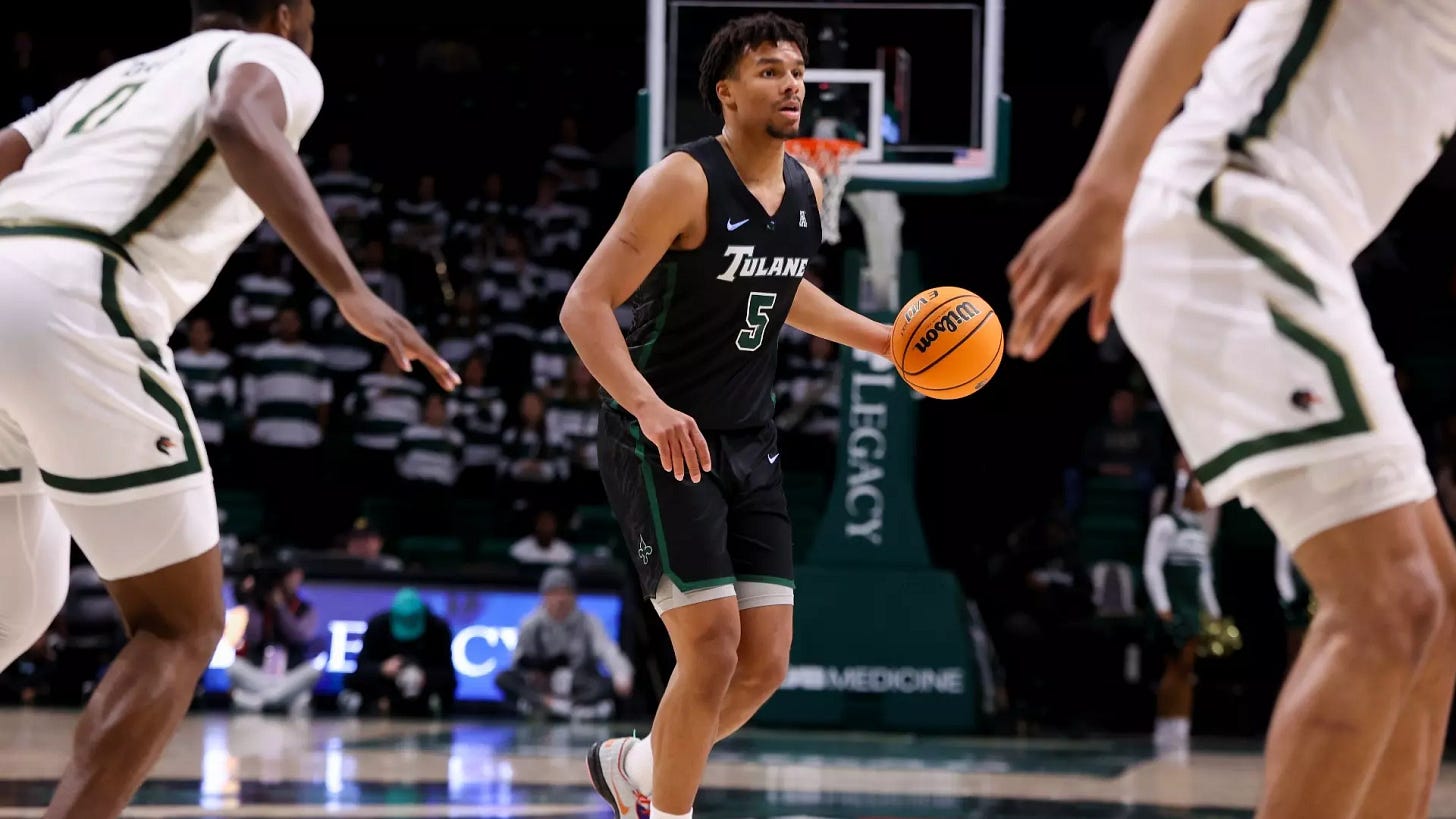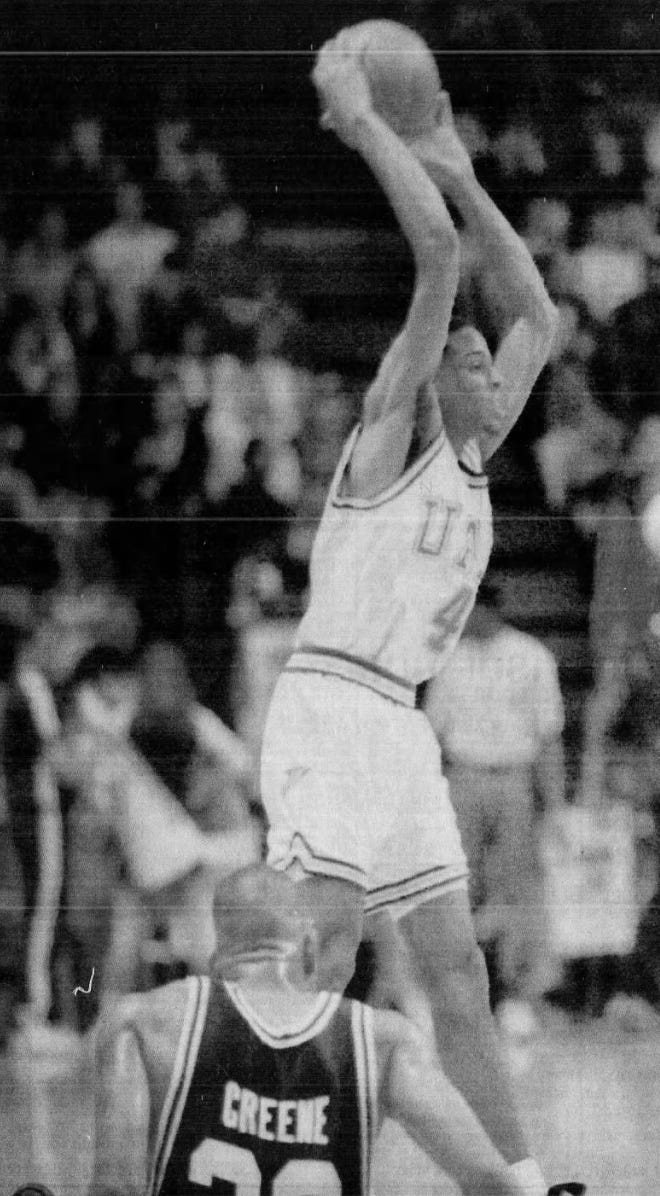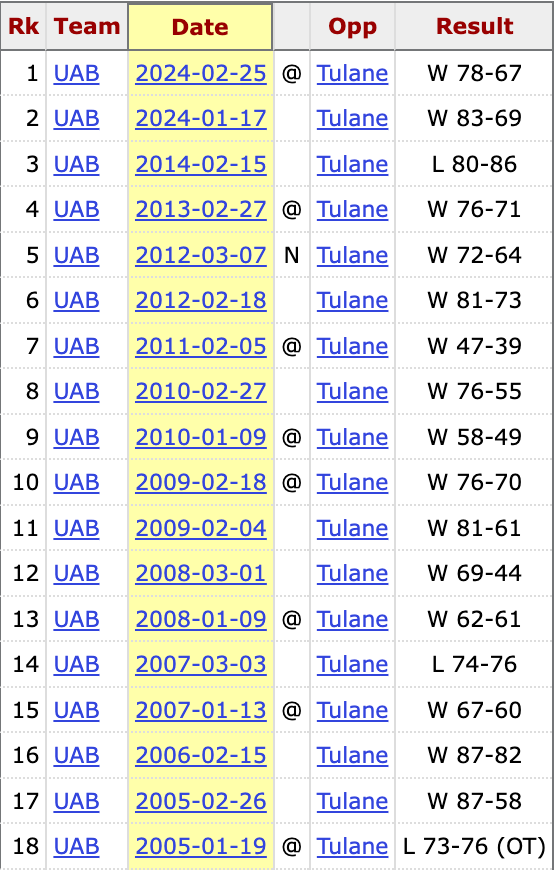Preview: Tulane Comes to Birmingham
Coming off a destruction of Tulsa, the Blazers (8-7, 1-1) welcome league-leading Tulane (8-7, 2-0) to Bartow Arena.
Game Information
UAB (8-7, KenPom #124) vs. Tulane (8-7, KenPom #168)
📅 Tuesday, January 7th, 2025
🕒 6:30 PM CST
🏟️ Birmingham, Alabama — Bartow Arena
📺 ESPN+ — Will Kollmeyer and Mo Finley
📻 WJQX 100.5 FM — David Crane and Steve Mitchell
Tonight marks the 1,500th game in UAB men’s basketball history, a milestone you can read more about here.
Trends and Odds
UAB enters the afternoon at 8-7 (1-1). The Blazers absolutely dominated Tulsa on Saturday to claim their first conference win of the season, holding the Golden Hurricane to a grotesque 0.71 points per possession. Andy Kennedy described the effort as “by far our best defensive performance of the year.”
The UAB coach had high praise for Alejandro Vasquez, who led all scorers with an efficient 27. The senior wing has now scored 15 or more points in three consecutive games for the first time since March 2024.
The Blazers have moved up 14 KenPom spots since the beginning of conference play; their #124 ranking places them sixth among American teams, and they’re gaining on #120 Temple.
Tulane enters the afternoon at 8-7 (2-0). In a late-December post that wasn’t published, I wrote:
Barring a miraculous turnaround, the Ron Hunter era is on its last legs in New Orleans. During his six-season tenure, Hunter has traditionally made up for mediocre-to-poor records with respectable KenPom rankings; unfortunately for him, Tulane is currently lacking both wins and analytic clout for the first time since the pandemic. The Green Wave have a thoroughly unimpressive resume, having beaten two non-D1 teams and having lost to a terrible New Orleans squad. They are almost unanimously a bottom-four team in the conference.
Through their first two games of league play, Tulane has smashed Charlotte and UTSA by a combined margin of 44, looking like an entirely new team in the process. Although their non-conference resume remains concerningly bad, it’s impossible to dismiss the Green Wave after the events of the last week — they’ve climbed from 205th in KenPom to 168th.
Neither UAB nor Tulane has beaten a KenPom top 200 team this season. Something has to give.
Barttorvik and KenPom each give the Blazers a 72% probability of beating Tulane and predict a final score of UAB 81, TU 75.
Series History
UAB holds a 26-13 all-time record against Tulane and has dominated the series in recent decades. The Wave has only beaten the Blazers twice since 2005.
The first meeting between UAB and Tulane remains one of the teams’ most compelling. The date was December 15th, 1992, and the Blazers were discontented. Now on the wrong side of Bartow’s halcyon days, it had been years since the program received significant national exposure.
“I haven’t beaten a ranked team since DePaul my freshman year,” UAB guard Stanley Jackson told the Birmingham Post-Herald.
18th-ranked Tulane, coming off its first-ever NCAA Tournament appearance, offered UAB water in the midst of the Blazers’ relevance drought. The Green Wave played an exciting, up-tempo style of basketball, hockey-style substituting its entire bench unit — a group known as “the Posse” — into the game with the intent to overwhelm the opponent. An ESPN crew descended on Birmingham to watch the Blazers take on coach Perry Clark’s squad.
In front of a raucous UAB Arena crowd of over 6,500, UAB and Tulane battled back and forth. Neither team claimed a significant advantage for the game’s first 30 minutes. It seemed as though the Blazers had seized control when they took a five-point lead with fewer than nine minutes on the clock, but the Green Wave’s pressure defense subsequently forced six consecutive UAB turnovers. Tulane soon roared back into the lead.
Led by guards Stanley Jackson and Carter Long, the Green and Gold responded with a game-ending 17-9 run, turning their opponents’ aggression against them.
“With the way they’re running and jumping on defense, there’s got to be a gap somewhere,” said Long. “They left open some three-pointers and we took advantage.”
Long nailed several long triples, the Blazers made 17 of their 21 second-half free throws, and the home team escaped by a score of 75-69, finally claiming its long-awaited ranked victory.
The two programs would see much more of each other after they became founding members of Conference USA in 1995. For the rest of the decade, UAB and Tulane waged a highly-competitive rivalry — at the turn of the millennium, the series score was 7-6 in favor of the Blazers. The balance of power would subsequently shift in the Green Wave’s favor, as they won 7 of the teams’ first 11 meetings of the 2000s. In 2005, UAB suffered a heartbreaking road overtime loss in which New Orleans native Squeaky Johnson missed two potential buzzer-beaters.
But the Blazers went on to crush Tulane in Birmingham just over a month later, a victory that catalyzed a still-active streak of comical dominance. Since February 26th, 2005, UAB has beaten the Green Wave 15 times in 17 tries; Tulane’s lone victories came against the 15-16 2007 team and the 18-13 2014 team.
Although Ron Hunter’s squad let one get away from them in Bartow last season, they made an concerted effort to score their first home win against UAB since the Squeaky game. However, excellent late-game free throw shooting by the Green and Gold repulsed an attempted Green Wave comeback and locked down a 78-67 Blazer victory.
Tulane Scouting Report
Ron Hunter has made a career out of revitalizing traditionally downtrodden programs. He got his first head coaching job at IUPUI, where he would oversee the team’s 1998 transition from Division II to Division 1. By 2004, Hunter had led the Jaguars to their first and only NCAA Tournament appearance. By 2008, he had snuck IUPUI — IUPUI! — into the KenPom top 70.
In 2011, Hunter headed south for Georgia State, historically one of the least successful D1 programs of all time. Nevertheless, he worked his magic and inspired another team to rise above its station: GSU won six conference titles, appeared in three NCAA Tournaments, scored a legendary March Madness upset over Baylor, and produced a first-round NBA Draft pick during Hunter’s eight-year tenure.
Following a murky 2019 contract dispute, the coach left Atlanta behind for Tulane, yet another success-deprived afterthought. In the 16 seasons leading up to Hunter’s arrival, the Green Wave posted a total of four winning records. Needless to say, they hadn’t sniffed the NCAA Tournament since Perry Clark’s aforementioned tenure.
In the vein of Tulsa’s 2022 hiring of Eric Konkol, which we discussed over the weekend, Tulane’s 2019 hiring of Hunter was considered a coup by many, but both coaches have since seen their shares of highs and lows.
Hunter hasn’t found the same success in New Orleans as he did at IUPUI or Georgia State, as he’s finished above the .500 mark just once. His saving grace has been the respect afforded to him by various algorithms. As I previously wrote: “During his six-season tenure, Hunter has traditionally made up for mediocre-to-poor records with respectable KenPom rankings.” The analytics would have you believe that the 14-15 2022 squad was the best team Tulane has fielded since Clark roamed the sidelines.
With last year’s roster decimated by graduation and the transfer portal, the Green Wave have ridden a cast of new characters to yet another uninspiring record; this time, they don’t have the KenPom rating to back it up. Although Tulane has surged since the start of conference play and will certainly present the Blazers with a challenge, Hunter is likely coaching for his job.
Almost any player you remember from last year’s Green Wave squad is gone. Kevin Cross? Jaylen Forbes? Collin Holloway? Sion James? Kolby King? One way or another, they all departed New Orleans over the summer.
Georgetown transfer Rowan Brumbaugh is Tulane’s new point guard. The former Texas Longhorn was a top-100 recruit coming out of high school in 2022, but he never saw the court in Austin. He spent last season playing a contributing role in the Hoya backcourt, averaging 8.3 points per game on 22.1 minutes per game while displaying flashes of excellence. Now in New Orleans, Brumbaugh has become Ron Hunter’s single most-used player, on the floor almost 80% of the time.
Brumbaugh is a capable distributor, initiating many of Tulane’s actions and sporting a top-90 assist rate in the country. Although not a particularly intimidating three-point shooter, he possesses the range to keep the defense honest — Hunter isn’t afraid to let him take a mid-range jumper — and is a good attacker and finisher, currently making dunks and layups at a 66.7% clip. All of these traits combined with his passable defense makes Brumbaugh a staple of the Green Wave’s rotation.
Returner Asher Woods, who averaged just 6.3 minutes per game last season, has enjoyed a campaign filled with playing time. He typically shares the backcourt with Brumbaugh, playing a complimentary role on offense. Although his assist rate is respectable, Woods is not much of a shot creator and is a below-average shooter at all three levels. Currently hitting three-pointers at a 28% clip and two-pointers at a 46% clip, Woods is the team’s least efficient player by eFG%.
Freshman wing Kam Williams is the only Tulane player to see the court more than Brumbaugh, and for good reason — last month, ESPN rated him among the ten best mid-major freshman in the country. The 6’8” former four-star prospect is obscenely efficient on the offensive end, attempting almost exclusively dunks and triples while making both shot types at an 80th percentile rate. He hasn’t created many of his own shots, but he hasn’t needed to: Tulane’s drive-and-kick offense generates Williams plenty of looks from above the break, most of which are assisted by Brumbaugh.
Williams also sports steal and block percentages north of 3.7% and turns the ball over at just an 8.5% rate. Yesterday, he was named the AAC’s Freshman of the Week after averaging 12 points and 6 rebounds in the Green Wave’s demolitions of Charlotte and UTSA.
Although he saw more consistent playing time earlier in the year, freshman guard Mari Jordan primarily serves as the backup to Woods and Williams. Jordan, a four-star recruit coming out of high school in 2023, spent last season with the Georgia Bulldogs but redshirted to preserve his eligibility, never appearing in a game. Jordan has struggled to find an offensive niche other than low-volume three-point shooter; he also comes in as Tulane’s third-least productive defender by EvanMiya’s BPM.
The Green Wave frontcourt is manned by forward Kaleb Banks and center Gregg Glenn, arguably Tulane’s best players. Banks has been a weapon on offense this season, averaging 18.1 points per game and grading out as the conference's top player by hoop-math’s offensive RAPM. The former Indiana transfer, who was horrid over two years under Mike Woodson, has revitalized himself in New Orleans, making his two-pointers at a 64% rate and nailing triples at a 36% rate — on decent volume! Banks also gets to the line with ease, almost never turns the ball over, and boasts one of the highest block rates in the conference.
Hunter recently described Glenn as a “Kevin Cross 2.0” who “we can run our offense through,” an assertion back up by his sky-high assist rate. The 6’7” junior doesn’t possess the frame of a typical center — Tulane doesn’t field a “typical center” — and is a dangerous passer, although he’s not that adept at creating offense for himself. Glenn is also as productive a per-minute rebounder as Banks and stands as one of the conference’s better defenders.
The lineup of Brumbaugh, Woods, Williams, Banks, and Glenn is what we’ll see a lot of today, as that group has been on the floor for nearly 30% of the Green Wave’s last five games.
Outlook
Ron Hunter has played a version of the same matchup zone defense since he was hired at IUPUI in 1994. Also known as an “amoeba zone,” Hunter’s complex system combines elements of man-to-man and zone defenses, adding a wrinkle to opponents’ game preparation. Andy Kennedy referenced the matchup zone in Saturday’s postgame interview, saying:
But very seldom do you get Saturday games, and Saturday-Tuesday is a quick turn against a team in Tulane that plays later this afternoon at home against UTSA. They play an unorthodox style with that matchup zone for 40 minutes that Ron Hunter's famous for.
On short rest against a team notoriously tough to prepare for, how effectively will UAB be able to score? They averaged 1.10 points per possession against the Green Wave in 2024, but that was against a TU frontline much less capable of rebounding than it is today. One thing is for certain: the Blazers will have to make open looks, something they’ve struggled with all season. Owing to the nature of Hunter’s defense, Tulane allows its opponents to take more three-pointers than any other team in the American.






